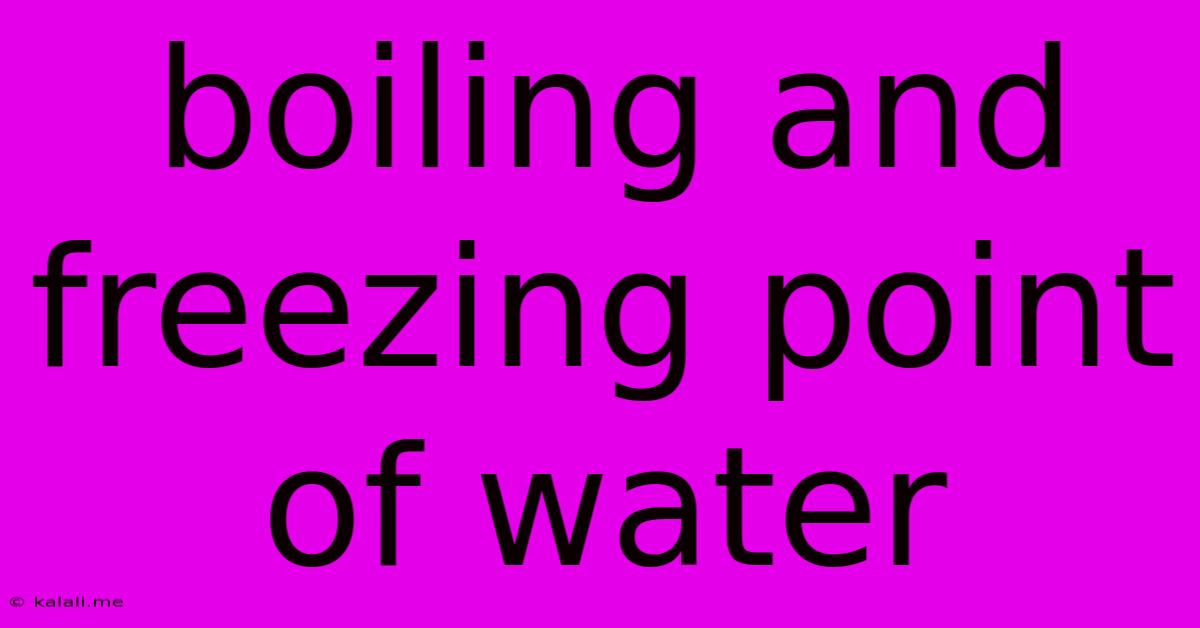Boiling And Freezing Point Of Water
Kalali
Jun 15, 2025 · 3 min read

Table of Contents
Boiling and Freezing Point of Water: A Deep Dive
Water, the elixir of life, exhibits unique properties that are fundamental to our existence. Understanding its boiling and freezing points is crucial in various scientific disciplines and everyday applications. This article delves into the science behind these critical temperature thresholds, exploring their significance and the factors influencing them. We'll also examine how these points can be manipulated and their implications in different contexts.
What are the boiling and freezing points of water? At standard atmospheric pressure (1 atmosphere or 101.325 kPa), water freezes at 0 degrees Celsius (32 degrees Fahrenheit) and boils at 100 degrees Celsius (212 degrees Fahrenheit). These temperatures represent the transition points between the different phases of water: solid (ice), liquid (water), and gas (steam).
Understanding the Boiling Point
The boiling point of water is the temperature at which the vapor pressure of water equals the surrounding atmospheric pressure. This means that the water molecules have enough kinetic energy to overcome the intermolecular forces holding them together in the liquid phase and escape into the gaseous phase, forming steam.
- Factors Affecting Boiling Point: Several factors can influence the boiling point of water:
- Altitude: At higher altitudes, atmospheric pressure is lower. This means water boils at a lower temperature. Think of cooking at high elevations – it often takes longer because the water boils at a lower temperature.
- Pressure: Increasing pressure increases the boiling point, while decreasing pressure lowers it. Pressure cookers utilize this principle to cook food faster at higher temperatures.
- Impurities: Dissolved substances in water can slightly alter its boiling point, a phenomenon known as boiling point elevation. The extent of the change depends on the concentration and nature of the impurities.
Understanding the Freezing Point
The freezing point of water is the temperature at which liquid water transitions to solid ice. At this point, the kinetic energy of the water molecules is sufficiently low for them to form a stable crystalline structure, the characteristic hexagonal lattice of ice.
- Factors Affecting Freezing Point: Similar to the boiling point, several factors can impact the freezing point of water:
- Pressure: While the effect is less pronounced than on the boiling point, increasing pressure slightly lowers the freezing point of water. This is why ice skates can glide on ice – the pressure from the skate blades slightly melts the ice, providing a lubricating layer.
- Impurities: Dissolved impurities, like salt, lower the freezing point of water. This is why salt is used to de-ice roads in winter; the salt solution has a lower freezing point than pure water, preventing ice formation. This phenomenon is known as freezing point depression.
The Importance of Boiling and Freezing Points
The boiling and freezing points of water are crucial in countless applications:
- Food preparation: Cooking, freezing, and preserving food rely heavily on the precise control of temperature around these points.
- Industrial processes: Many industrial processes, like steam generation and refrigeration, depend on the phase transitions of water.
- Meteorology: Understanding the freezing and boiling points is essential for predicting weather patterns and understanding phenomena like cloud formation and precipitation.
- Biology: The unique properties of water, including its relatively high boiling and freezing points compared to similar molecules, are fundamental to life as we know it.
Conclusion
The boiling and freezing points of water are not just arbitrary numbers; they are fundamental physical properties with profound implications across various scientific and everyday contexts. Understanding these points and the factors that influence them provides invaluable insight into the behavior of water and its importance in our world. Further research into these properties continues to reveal new insights and applications, highlighting the enduring significance of this seemingly simple substance.
Latest Posts
Latest Posts
-
The Innermost Layer Of The Root Cortex Is The
Jun 15, 2025
-
The Krebs Cycle Is Also Called The
Jun 15, 2025
-
What Are The Multiples For 14
Jun 15, 2025
-
What Is The Factors Of 100
Jun 15, 2025
-
How Many Valence Electrons Are Present In Silicon
Jun 15, 2025
Related Post
Thank you for visiting our website which covers about Boiling And Freezing Point Of Water . We hope the information provided has been useful to you. Feel free to contact us if you have any questions or need further assistance. See you next time and don't miss to bookmark.